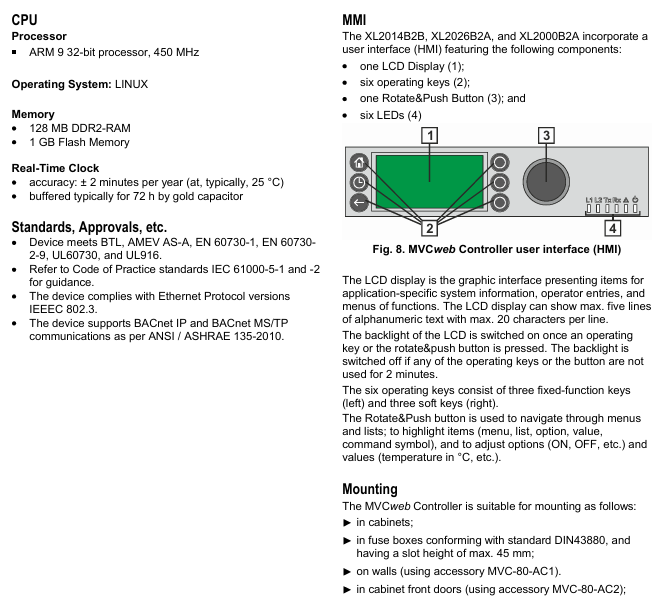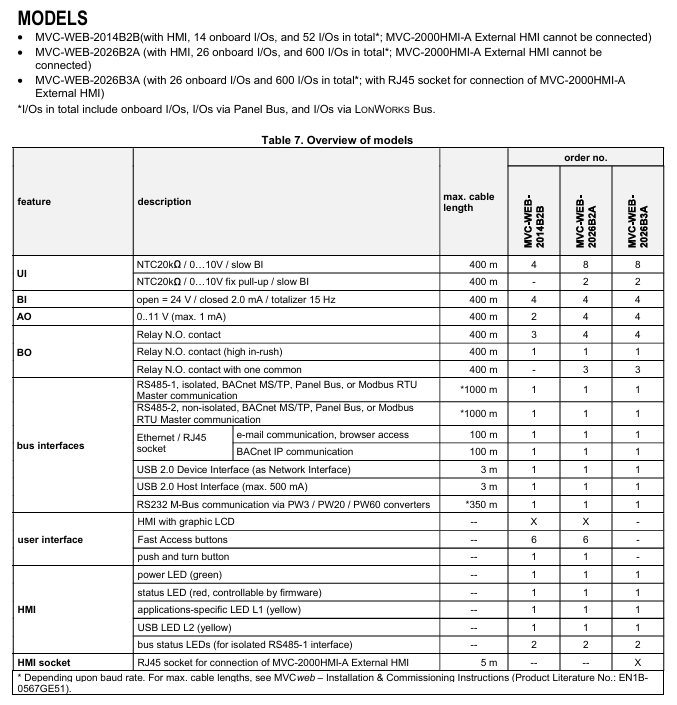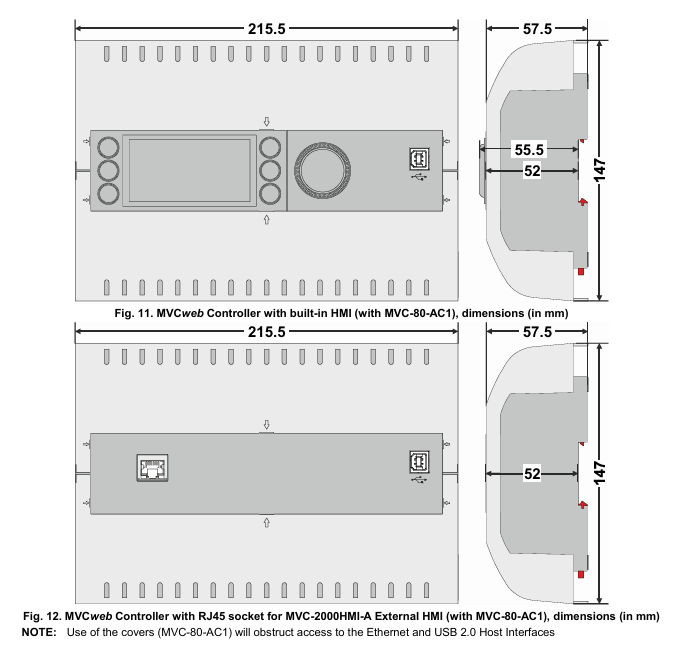

K-WANG


HONEYWELL EXCEL 5000 OPEN SYSTEM
HONEYWELL EXCEL 5000 OPEN SYSTEM
The Honeywell MVCweb control system is a programmable building automation controller based on open standards (belonging to the Honeywell EXCEL 5000 open system). Its core positioning is to reduce the full lifecycle cost of buildings, while supporting multi scenario building management functions. It has flexible communication compatibility, remote operation and maintenance capabilities, and high reliability, and is suitable for HVAC( heating, ventilation, and air conditioning, heating, ventilation, and air conditioning)、 Building automation scenarios such as energy management and lighting control.
Core Features and Advantages
Cost optimization design
Hardware cost: Reuse existing Ethernet/LAN infrastructure to reduce communication cabling investment; Supports flexible selection of onboard I/O and Panel Bus I/O to avoid redundant configurations.
Operation and maintenance costs: No need to separately maintain the operator interface software (software integrated into the controller, following the "single source principle"); Support remote browser access to reduce on-site operation and maintenance frequency.
Open compatibility and multi protocol support
Communication standard: Fully compatible with international mainstream building communication protocols, including BACnet/IP(ISO 16484-5)、BACnet MS/TP(ISO 16484-5)、LONWORKS(ISO 14908)、Modbus RTU Master、M-Bus(EN 1434-3), Seamless integration with third-party BACnet devices and Honeywell front-end systems (such as Enterprise Buildings integrator) ™、 SymmetrE and LONWorks devices.
Manufacturer independence: Based on open protocol design, there is no need to rely on a single supplier, reducing the limitations of system upgrades and extensions.
Flexible operation and monitoring
Remote access: Built in web server, supports local/remote operation on any networked PC (laptop, desktop, touch screen) through standard browsers (IE 9.0. x, Mozilla Firefox 15.0. x, etc.), compatible with WIN CE system 320x240 pixel touch screen (such as Excel Touch).
Data Trend and Alarm: Supports trend recording for 100 data points; The built-in email/SMS alarm function can send the alarm information to the mailbox or mobile phone through the network or Internet DSL connection, and the alarm rules can be customized.
High reliability and security guarantee
Stable operation: It is equipped with an embedded LINUX system to ensure an independent and safe operating environment, especially suitable for scenarios requiring access to the Internet.
Network security: it needs to be deployed on a private network (such as VPN) or isolated from the Internet through an external firewall; Support 6 levels of user permission management, each level can be configured with independent read and write permissions and passwords to prevent unauthorized operations.
Fault Monitoring: Equipped with M-Bus and Modbus slave device communication fault detection functions, it can automatically retry communication and mark fault status to ensure data collection continuity.

Core functions and technical parameters
1. Control and application capabilities
Function category details
Application scenarios include HVAC control (such as optimal start stop, nighttime purification, maximum load demand control), lighting monitoring, shading control, heat/energy metering, etc
Control performance supports 4 levels of optional control loop priority (multitasking), optional control loop cycle time, event driven switching table, and adapts to the control accuracy requirements of different scenarios
The programming tool allows for free programming through graphical CARE engineering tools, supports existing applications and macro instruction reuse, and has online debugging capabilities
2. Communication interface and parameters
(1) Main communication interface configuration
Number/specifications of interface types, supported protocols/functions, maximum transmission distance
Ethernet (RJ45) 1 10/100 Mbit/s, BACnet/IP communication, browser access, FTP firmware download 100m
RS485 2 (1 isolated, 1 non isolated) BACnet MS/TP, Panel Bus, Modbus RTU Master (only 1 interface can be used simultaneously) 1000m (depending on baud rate)
RS232 (RJ45) 1 M-Bus communication (requires PW3/PW20/PW60 converter), factory debugging 350m (M-Bus)
USB 2.0 2 (1 Host, 1 Device) Host: Connect IF-LON interface (maximum 500mA); Device: Connect CARE tool, touch screen 3m
1 HMI interface (some models) with built-in LCD display screen (5 lines x 20 characters), 6 operation keys, and 1 rotary press key; Some models support external MVC-2000HMI-A 5m (external HMI)
(2) Key communication protocol parameters
M-Bus: Supports 300/2400/9600 Baud, connects up to 60 slave devices, configurable measurement cycle (1-7 days), slave device address range 1-250.
Modbus RTU Master: supports 9.6-115.2 kBaud, can connect up to 32 slave devices, with an address range of 1-247; Supports 16/32-bit registers, with data types including BOOL, INT16/UINT16, INT32/UINT32, FLOAT; Support CRC frame check, 1-2 stop bits, optional parity check (none/odd/even).
LONWorks: Requires IF-LON interface (FTT-10A/FT-X1 transceiver), communication rate of 78 Kbaud, maximum cable length of 320-2200m (depending on topology).
3. Environmental and electrical parameters
Parameter category specification
Working temperature wall mounted installation: 0-40 ℃; Cabinet interior/cabinet door installation: 0-50 ℃
Storage temperature -20-70 ℃
Relative humidity 5% -95% (no condensation)
Protection level wall mounted (with MVC-80-AC1 cover): IP20; Cabinet door installation (with MVC-80-AC2): IP30
Power supply 19-29 VAC (50/60Hz) or 20-30 VDC
Power consumption DC: typical 5W, maximum 6W; AC: typical 9VA, maximum 11VA
CPU and Memory: ARM 9 32-bit processor (450 MHz); 128 MB DDR2-RAM,1 GB Flash Memory

Model classification and hardware configuration
The MVCweb series includes three core models, with main differences in onboard I/O quantity, HMI configuration, and external HMI support capability. The total I/O quantity includes onboard I/O, Panel Bus I/O, and LONWorks Bus I/O.
Model, onboard I/O quantity, total I/O quantity, HMI configuration, external HMI support
MVC-WEB-2014B2B 14 with 52 built-in HMIs (LCD+buttons) not supported
MVC-WEB-2026B2A with 26 built-in HMIs (LCD+buttons) and 600 built-in HMIs is not supported
MVC-WEB-2026B3A 26, 600 without built-in HMI support (including RJ45 interface, can be connected to MVC-2000HMI-A)
Typical I/O types and specifications (taking 26 onboard I/O as an example)
Analog Input (AI): Supports NTC20k temperature sensor, 0-10V signal, maximum transmission distance of 400m.
Digital Input (DI): Supports 24V open circuit/2.0mA closed signal, total counting frequency 15Hz, maximum transmission distance 400m.
Analog output (AO): 0-11V signal (maximum 1mA), maximum transmission distance 400m.
Digital output (DO): Relay normally open contacts (including high surge current type), maximum transmission distance of 400m.
Installation and usage precautions
Wiring requirements
M-Bus/Modbus: Shielded twisted pair cable (J-Y - (St) - Y 2 × 2 × 0.8) is required, with the shielding layer grounded at one end; Modbus only supports daisy chain topology, with branch lengths not exceeding 20m.
Power isolation: It is prohibited to share transformer power supply with other controllers/devices (such as PW M-Bus adapters) to avoid interference.
Electrostatic protection: During installation, it is necessary to follow the rules for electrostatic discharge protection to avoid damaging the equipment.
Accessories and Selection
Essential accessories: detachable terminal plug (TPU-45-01), terminal cover (MVC-80-AC1), cabinet door installation accessories (MVC-80-AC2), strain relief (MVC-40-AC3), etc. (to be purchased separately).
Signal conversion: If you need to convert a 0-20mA signal to 0-10VDC, you can use the auxiliary terminal pack (XS831).
Compliance and Certification
Compliant with multiple international standards: BTL, AMEV AS-A, EN 60730-1/2-9, UL60730, UL916, as well as Ethernet IEEE 802.3, BACnet ANSI/ASHRAE 135-2010.
Document reference: Follow the product manual (EN1B-0567GE51), protocol conformity statement (EN0B-0716GE51), and network security white paper (EN2B-0398GE51).

- YOKOGAWA
- Energy Access
- Renewable Integration
- Energy Subsidies
- Energy and Water
- Net zero emission
- Energy Security
- Critical Minerals
- A-B
- petroleum
- Mine scale
- Energy and Gender
- Covid-19
- man-machine
- Reliance
- ADVANCED
- SEW
- ProSoft
- WATLOW
- Kongsberg
- FANUC
- VSD
- DCS
- PLC
- Sewage treatment
- cement
- Yaskawa
- Woodward
- BOSCH Rexroth
- MOOG
- General Electric
- American NI
- Rolls-Royce
- CTI
- Honeywell
- EMERSON
- Automobile market
- xYCOM
- Motorola
- architecture
- Industrial information
- New energy
- electricity
- Construction site
- HIMA
- ABB
- Rockwell
- Schneider Modicon
- Siemens
- MAN
- GE
- TRICONEX
- Control Wave
- ALSTOM
- AMAT
- STUDER
- KONGSBERG
- MOTOROLA
- DANAHER MOTION
- Bentley
- Galil
- EATON
- MOLEX
- Triconex
- DEIF
- B&W
- ZYGO
- Aerotech
- DANFOSS
- KOLLMORGEN
- Beijer
- Endress+Hauser
- schneider
- Foxboro
- KB
- REXROTH
- YAMAHA
- Johnson
- Westinghouse
- WAGO
- TOSHIBA
- TEKTRONIX
-
GE Hydran M2-X Enhanced Monitoring
-
ABB REG316 1mrk000809-GA Numerical Generator Protection
-
ABB RED670 1MRK004810 Line differential protection
-
GE SR750-P5-G5-S5-HI-A20-R-E Feeder protection system
-
ABB PFTL301E-1.0KN 3BSE019050R1000 PillowBlock Load cells
-
Kollmorgen S33GNNA-RNNM-00 - Brushless Servo Motor
-
Kollmorgen 6sm56-s3000-g-s3-1325 - Servo Motor
-
Kollmorgen AKM52K-CCCN2-00 - Servo Motor
-
Kollmorgen PSR3-230/75-21-202 - Power Supply
-
Kollmorgen akm24d-anc2r-00 - Servo Motor
-
Kollmorgen AKM22E-ANCNR-00 - Servo Motor
-
Kollmorgen S60300-550 - Servo Drive
-
Kollmorgen B-204-B-21 - Servomotor
-
Kollmorgen AKM21E-BNBN1-00 - Servo Motor
-
Kollmorgen TT2953-1010-B - DC Servo Motor
-
Kollmorgen pa8500 - Servo Power Supply
-
Kollmorgen BDS4A-210J-0001-207C2 - Servo Drive
-
Kollmorgen TTRB1-4234-3064-AA - DC Servo Motor
-
Kollmorgen MH-827-A-43 - Servo Motor
-
Kollmorgen AKM24D-ACBNR-OO - Servo Motor
-
Kollmorgen 00-01207-002 - Servo Disk DC Motor
-
Kollmorgen AKM21C-ANBNAB-00 - Servo Motor
-
Kollmorgen PSR3-208/50-01-003 - Power Supply
-
Kollmorgen 6SM56-S3000 - Servo Motor
-
Kollmorgen DBL3H00130-B3M-000-S40 - Servo Motor
-
Kollmorgen 6SN37L-4000 - Servo Motor
-
Kollmorgen AKM65K-ACCNR-00 - Servo motor
-
Kollmorgen 6SM56-L3000-G - Servo Motor
-
Kollmorgen AKMH43H-CCCNRE5K - Servo Motor
-
Kollmorgen PSR4/52858300 - Power Supply
-
Kollmorgen KBM-79H03-E03 - Direct Drive Rotary Motor
-
Kollmorgen AKM33E-ANCNDA00 - Servo Motor
-
Kollmorgen U9M4/9FA4T/M23 - ServoDisc DC Motor
-
Kollmorgen AKM13C-ANCNR-00 - Servo Motor
-
Kollmorgen AKM43L-ACD2CA00 - Servo Motor
-
Kollmorgen AKM54K-CCCN2-00 - Servo Motor
-
Kollmorgen M-605-B-B1-B3 - Servo Motor
-
Kollmorgen AKD-P00606-NBAN-0000 - Rotary Drive
-
Kollmorgen 6SM-37M-6.000 - Servo Motor
-
Kollmorgen A.F.031.5 - Sercos Interface Board
-
Kollmorgen 918974 5054 - Servo PWM
-
Kollmorgen U12M4 - ServoDisc DC Motor
-
Kollmorgen AKD-B00606-NBAN-0000 - Servo Drive
-
Kollmorgen MV65WKS-CE310/22PB - Servo Drive
-
Kollmorgen 65WKS-CE310/22PB - Servo Drive
-
Kollmorgen EM10-27 - Module
-
Kollmorgen S64001 - Servo Drive
-
Kollmorgen CR03200-000000 - Servo Drive
-
Kollmorgen 6SM57M-3000+G - Servo Motor
-
Kollmorgen BDS4 - Servo Drive
-
Kollmorgen AKD-P00306-NBEC-000 - Servo Drive
-
Kollmorgen AKD-B01206-NBAN-0000 - Servo Drive
-
Kollmorgen STP-57D301 - Stepper Motor
-
Kollmorgen 6SM37L-4.000 - Servo Motor
-
Kollmorgen 44-10193-001 - Circuit Board
-
Kollmorgen PRDR9SP24SHA-12 - Board
-
Kollmorgen PRD-AMPE25EA-00 - Servo Drive
-
Kollmorgen DBL3N00130-0R2-000-S40 - Servo Motor
-
Kollmorgen S406BA-SE - Servo Drive
-
Kollmorgen AKD-P00607-NBEI-0000 - Servo Drive
-
Kollmorgen AKD-P01207-NBEC-0000 - Servo Drive
-
Kollmorgen CR03550 - Servo Drive
-
Kollmorgen VSA24-0012/1804J-20-042E - Servo Drive
-
Kollmorgen N2-AKM23D-B2C-10L-5B-4-MF1-FT1E-C0 - Actuator
-
Kollmorgen 04S-M60/12-PB - Servo Drive
-
Kollmorgen H33NLHP-LNW-NS50 - Stepper Motor
-
Kollmorgen A-78771 - Interlock Board
-
Kollmorgen AKM43E-SSSSS-06 - Servo Motor
-
Kollmorgen AKD-P00607-NBEC-0000 - Servo Drive
-
Kollmorgen E21NCHT-LNN-NS-00 - Stepper Motor
-
Kollmorgen cr10704 - Servo Drive
-
Kollmorgen d101a-93-1215-001 - Motor
-
Kollmorgen BDS4A-203J-0001-EB202B21P - Servo Drive
-
Kollmorgen MCSS23-6432-002 - Connector
-
Kollmorgen AKD-P01207-NACC-D065 - Servo Drive
-
Kollmorgen CK-S200-IP-AC-TB - I/O Adapter and Connector
-
Kollmorgen CR10260 - Servo Drive
-
Kollmorgen EC3-AKM42G-C2R-70-04A-200-MP2-FC2-C0 - Actuator
-
Kollmorgen BDS5A-206-01010-205B2-030 - Servo Drive
-
Kollmorgen s2350-vts - Servo Drive
-
Kollmorgen AKM24D-ANC2DB-00 - Servo Motor
-
Kollmorgen E31NCHT-LNN-NS-01 - Stepper Motor
-
Kollmorgen PRD-0051AMPF-Y0 - Servo Board
-
Kollmorgen TB03500 - Module
-
Kollmorgen 60WKS-M240/06-PB - Servo Drive
-
Kollmorgen M21NRXC-LNN-NS-00 - Stepper Motor
-
Kollmorgen H-344H-0212 - Servo Motor
-
Kollmorgen MCSS08-3232-001 - Connector
-
Kollmorgen AKM33H-ANCNC-00 - Servo Motor
-
Kollmorgen PA-2800 - Power Supply
-
Kollmorgen MTC308C1-R1C1 - Servo Motor
-
Kollmorgen PRDR0091300Z-00 - Capacitor Board
-
Kollmorgen BDS4A-206J-0024/01502D79 - Servo Drive
-
Kollmorgen S20330-VTS - Servo Drive
-
Kollmorgen S20250-CNS - Servo Drive
-
Kollmorgen SBD2-20-1105-WO - Servo Drive Board
-
Kollmorgen M405-C-A1--E1 - Servo Motor
-
Kollmorgen PRD-PB805EDD-00 - Servo Drive
-
Kollmorgen 6SM57S-3.000-J-09-HA-IN - Servo Motor
-
Kollmorgen AKM33H-ANCNDA-00 - Servo Motor
-
Kollmorgen PCB-00030200-04 - PCB
-
Kollmorgen H22SSLB-LNN-NS-02 - Stepper Motor
-
Kollmorgen BJRL-20012-110001 - Module
-
Kollmorgen BDS4A-206J-0001404A - Servo Drive
-
Kollmorgen H-342-H-0802 - Servo Motor
-
Kollmorgen CR10561 - Servo Drive
-
Kollmorgen BDS5A-206-00010-205B2-030 - Servo Drive
-
Kollmorgen BDS5A-206-00010-207B-2-030 - Servo Drive
-
Kollmorgen mcss08-3224-001 - Connector
-
Kollmorgen M-207-B-23-B3 - Servo Motor
-
Kollmorgen PRD-0041200Z-S0 - Encoder/Resolver Card
-
Kollmorgen MH-225-G-61 - Motor
-
Kollmorgen MT308B1-T1C1 - Servo Motor
-
Kollmorgen BDS4A-240J-0001604C83 - Servo Drive
-
Kollmorgen 6SM57-S-3000 - Servo Motor
-
Kollmorgen N-T31V-15-5B-6-MF3-FT1E-C251 - Actuator
-
Kollmorgen PRD-0051AMPA-X0 - Servo Board
-
Kollmorgen CF-SS-RHGE-09 - Cable
-
Kollmorgen DIGIFAS7204 - Servo Drive
-
Kollmorgen S30101-NA - Servo Drive
-
Kollmorgen DIGIFAS7201 - Servo Drive
-
Kollmorgen PRD-0051AMPA-Y0 - Servo Board
-
Kollmorgen AKM23D-EFCNC-00 - Servo Motor
-
Kollmorgen SE10000 - Servo Drive
-
Kollmorgen PSR4/5A-112-0400 - Power Supply
-
Kollmorgen AKM31H-ANCNC-01 - Servo Motor
-
Kollmorgen M-203-B-93-027 - Servo Motor
-
Kollmorgen CP-SS-G1HE-05 - Connector




